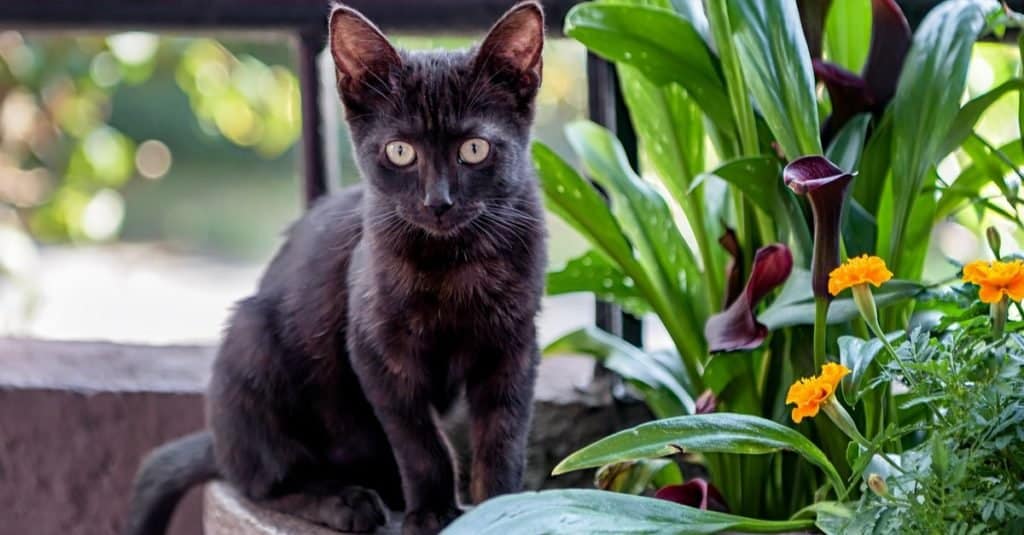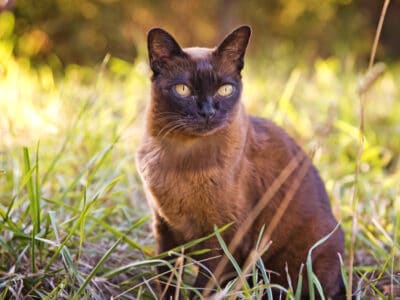Bombay
.jumbotron {
background-image: url(“https://a-z-animals.com/media/2019/11/Bombay-header-400×300.jpg”);
}
}
@media only screen and (min-width: 641px) and (max-width: 920px) {
.jumbotron {
background-image: url(“https://a-z-animals.com/media/2019/11/Bombay-header-470×370.jpg”);
}
}
@media only screen and (min-width: 921px) {
.jumbotron {
background-image: url(“https://a-z-animals.com/media/2019/11/Bombay-header.jpg”);
}
}
Bombay
Felis catus
Bred to look like a black panther!
Bombay Scientific Classification
- Kingdom
- Animalia
- Phylum
- Chordata
- Class
- Mammalia
- Order
- Carnivora
- Family
- Felidae
- Genus
- Felis
- Scientific Name
- Felis catus
Read our Complete Guide to Classification of Animals.
Bombay Conservation Status
Bombay Facts
- Fun Fact
- Bred to look like a black panther!
- Temperament
- Intelligent, energetic, calm and friendly
- Diet
- Omnivore
This post may contain affiliate links to our partners like Chewy, Amazon, and others. Purchasing through these helps us further the A-Z Animals mission to educate about the world’s species..

Spiders that fly! Fish that walk! And 1000+ more incredible animals. Discover them all for FREE
.photo-gallery {
–margin: 0px auto 0px;
–padding: 0px 0px 0px 0px;
}
.gallery-link {
background-image: url(“https://a-z-animals.com/media/2019/11/Bombay-close-up-1024×535.jpg”);
background-repeat: no-repeat;
background-size: cover;
background-position: center;
height: 500px;
justify-content: center;
text-align: center;
align-items: center;
display: flex;
border: 2px solid #000;
}
.gallery-link img {
height: 50%;
}
@media only screen and (max-width: 768px) {
.gallery-link {
height: 300px !important;
}
}
View all of the Bombay images!
The Bombay is a hybrid cat with a distinctive jet-black appearance.
Despite the name, this crossbreed did not actually originate from the Indian city of Bombay (now known as Mumbai). Instead, it was developed in the United States from a cross between a sable Burmese and a black American Shorthair. The Burmese itself was only developed a few decades earlier than that from a Siamese-like cat. A breeder by the name of Nikki Horner from Louisville, Kentucky was responsible for creating the Bombay starting in 1958. Her intention was to create a hybrid breed that resembled a small black panther, which is native to India (hence her choice of name). Decades after Nikki Horner succeeded, the Bombay gained full recognition from the Cat Fanciers’ Association in the 1970s.
See all of our expert product reviews.
Bombay Traits: What to Know before You Buy
- The Bombay is a highly sociable breed. It craves constant attention from its owner.
- The Bombay loves playing games or fetching balls. Sometimes they will even accept being walked around on a leash. This should give it plenty of exercise and fresh air.
- The Bombay loves to hide under warm blankets or in sunlit corners. Be careful when getting into bed.
- Despite being a light shedder, the Bombay is not completely hypoallergenic. With that said, individual reactions will always vary, even with supposedly hypoallergenic cats. There’s no way to know how you will react until you’ve already had experience with a particular cat breed.
- The short and shiny coat of hair should be groomed about once a week with a rubbery curry brush. Owners will also need to provide frequent ear checks, nail trimmings, and teeth brushing with an acceptable, vet-approved toothpaste.
Bombay Personality
The Bombay, like the closely related Burmese from which it originated, is one of the more affectionate and people-oriented breeds of cat you can find. These calm and laid-back cats are very friendly with children, strangers, and even other animals. They have been nicknamed the Velcro cats for their tendency to follow people around the home and insinuate their way into your activities, even when you want to be left alone. There may be one specific person with whom they show the most affection and bond.
button.pulse {
transform: scale(1); animation: pulse 2s infinite;
box-shadow: 0 0 0 0 rgba(11, 247, 25, 1);
}
@keyframes pulse {
0% { transform: scale(0.90); box-shadow: 0 0 0 0 rgba(11, 247, 25, 0.5); }
60% { transform: scale(1); box-shadow: 0 0 0 15px rgba(11, 247, 25, 0); }
100% { transform: scale(0.90); box-shadow: 0 0 0 0 rgba(11, 247, 25, 0); }
}
Owners should be aware, however, that the Bombay cannot be left alone for long periods of time. A high-strung cat suffering from separation anxiety will start to engage in destructive behavior around the home. If you plan to leave them alone for hours at a time, then you should provide them with plenty of toys, a scratching post, and other activities. It’s also a good idea to have someone check in on them from time to time. This is one reason they do well with families.

Viktor Sergeevich/Shutterstock.com
Bombay Size and Weight
The Bombay is a medium-sized cat, measuring between 13 and 20 inches long, with a muscular frame and a long tail. It usually weighs somewhere in the range of 8 to 15 pounds, but males are generally larger than females on average.
Bombay Price
The price of a new Bombay kitten will probably be somewhere in the range of $400 to $1,000. For a cat with an exceptional pedigree, you may end up spending well over a thousand dollars. If you’re just interested in adopting an older cat, however, then you probably won’t pay more than a few hundred dollars. From the right rescue shelter, these cats should be well cared for and up to date on their health checkups.
Health and Entertainment for your Bombay
See all of our expert product reviews.
Bombay Kittens
Bombay kittens are very energetic and playful pets. They are an enormous source of joy but also responsibility. Beginning within the first one to three months of age, kittens will benefit from early socialization and training in order to become well-behaved adults. Introduce your cat to new people slowly and patiently, with a calm voice and deliberate movements, so that it can set the pace of interactions as it pleases. These cats are also fairly responsive to a few basic commands and may even accept leash training.
Bombay kittens will reach sexual maturity quickly, perhaps as early as five months old. If you plan to spay or neuter them, this should be done by the six to nine-month mark. Spaying or neutering, which has numerous benefits for the cat’s health (including its risk of developing cancer) and behavior, is usually the preferred option unless you plan to deliberately breed your cats.

Lux Blue/Shutterstock.com
Bombay Lifespan
The Bombay has a typical lifespan of 12 to 18 years. It’s very uncommon, though not impossible, that the cat may exceed 18 years of age. While generally healthy, they can suffer from gingivitis, sinus problems, head defects, and a potentially fatal heart condition called hypertrophic cardiomyopathy in which the heart grows too large and the walls thicken. Cardiomyopathy is so serious, in fact, that you should never buy a kitten if its parents have not been tested for this condition. While no breeder can entirely prevent all health problems from ever developing, they can ensure that your cat has a better chance at living a long and healthy life. Regular health checkups at the vet are also a necessity to maintain good health.
Bombay Breed vs. Mixed
A typical Bombay will have a short glossy black coat, rounded head, medium-sized ears, long body and legs, and gold or copper eyes. Besides the black coat, it actually looks quite similar to the Burmese. This is no surprise, given that the Bombay was originally developed from the Burmese in the 1950s and 1960s. The Bombay can be mixed with any other breed of cat to produce some truly interesting results. However, by far the most common cross is with the sable Burmese. This is done on occasion in order to maintain the Bombay’s physical characteristics, which might otherwise drift from the accepted standard. It is not usually crossed again with the black American Shorthair, its other parent breed, due to a difference in body type.
Types of Bombay Cats and Colors
There are generally two types of Bombay cats: the American and British. Functionally, there are few differences between them, except the British variety may include more crosses with domestic black shorthair cats. The Cat Fanciers’ Association recognizes only a single color: black. This color covers almost everything besides the eyes and ears, including the entire coat, the soles, the nose, and the mouth. The black color goes all the way down to the roots with no other colors mixed in.
View all 192 animals that start with B
Bombay FAQs (Frequently Asked Questions)
Are Bombays herbivores, carnivores, or omnivores?
Bombays are Omnivores, meaning they eat both plants and other animals.
What Kingdom do Bombays belong to?
Bombays belong to the Kingdom Animalia.
What class do Bombays belong to?
Bombays belong to the class Mammalia.
What phylum to Bombays belong to?
Bombays belong to the phylum Chordata.
What family do Bombays belong to?
Bombays belong to the family Felidae.
What order do Bombays belong to?
Bombays belong to the order Carnivora.
What genus do Bombays belong to?
Bombays belong to the genus Felis.
What type of covering do Bombays have?
Bombays are covered in hair.
How many babies do Bombays have?
The average number of babies a Bombay has is 6.
What is an interesting fact about Bombays?
Bombays were bred to look like black panthers!
What is the scientific name for the Bombay?
The scientific name for the Bombay is Felis catus.
What is a Bombay cat?
The Bombay is a hybrid crossbreed short-haired cat developed from the sable Burmese and the black American Shorthair by the breeder Nikki Horner starting in 1958. This is a friendly and affectionate breed with a very distinctive glossy coat of black fur. It’s one of the few breeds, in fact, that comes in nothing but black. The intention was to create a panther-like appearance.
How do I know if my cat is a Bombay?
The easier way to identify the Bombay is the short, all-black coat of fur. While other black cats are quite common, the glossy coat and the sleek but still relatively muscular and athletic body type should help to distinguish this breed in particular from others. The affectionate and sociable personality is another giveaway.
Is a Bombay cat rare?
The Bombay is not exactly common; most people don’t even know they exist. But determined owners willing to travel out of town or sometimes even out of state will be able to find a breeder, a breed-specific rescue group, or simply someone who wants to sell their cat. Trying your luck at a random shelter probably won’t yield any results, unfortunately. Owners are quite protective of this crossbreed cat.
Are Bombay cats expensive?
The price of a new Bombay kitten shouldn’t be too expensive in relation to other uncommon purebred cats. If you can somehow find one up for adoption in an animal shelter, then they should be relatively cheap, perhaps no more than $200. If you’re buying from a dedicated breeder or owner, then you will probably pay $400 or more.
Are Bombay cats dangerous?
No, Bombay cats tend to be sweet and affectionate, even more so than an average cat breed. They should pose no problems for small children or other pets. In fact, they tend to get along very well with them as long as they’re properly socialized early on to respect other people and animals.
Sources
- Cat Fanciers Association, Available here: https://cfa.org/bombay/bombay-breed-standard/
- Cat Time, Available here: https://cattime.com/cat-breeds/bombay-cats#/slide/1
- Vet Street, Available here: http://www.vetstreet.com/cats/bombay#overview



















